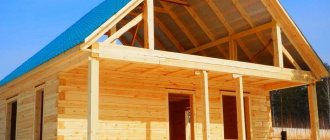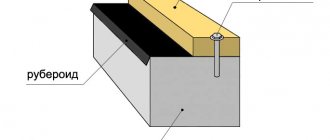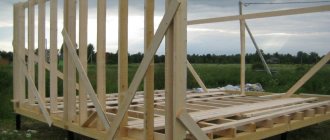Without approval from government agencies, the construction of a private residential building is regarded as unauthorized construction.
The procedure for obtaining permission to build a house in accordance with Federal Law No. 340, which entered into force on August 3, 2018, has been simplified, a declarative (notification) procedure has been established, and the package of documents has been reduced.
For individual housing construction, the new rules are mandatory from 08/04/2019, for SNT and private household plots - from 03/01/2019. And for those who received permission according to the old standards (before 08/04/2018), a new notification for approval of construction does not need to be submitted.
What land can you build on?
Only lands of settlements and in some situations for agricultural purposes are intended for the construction of housing (but the ban strictly applies to agricultural land):
- ZNP – for real estate in settlements, the boundaries are determined by urban planning regulations;
- ZAKH - plots for agricultural activities, there are some restrictions.
In the above two categories, the construction of residential buildings is allowed. It is impossible to build on lands of specially protected, industrial and other target statuses, water and forest funds, except in cases of changing the regime to conditionally permitted.
Construction of individual housing is permitted only on the following sites:
- intended directly for individual housing construction,
- Private household plots (subsidiary farms),
- related to populated areas,
- on garden plots.
Features of status and types of plots
It should be noted that the term “dacha plots” has been abolished (along with DNP). Now these are the lands:
- garden – it is allowed to create housing on the site, in this case it will be called “garden houses”;
- gardening - only for outbuildings, cabins, and similar non-permanent structures for periodic residence.
Now, according to the law, there are no official terms “dachas”, “dacha houses”, “dacha farms”, but there are individual housing construction objects (residential buildings) and garden houses. For the latter, nothing was previously required to be submitted, but now notification is required, but you can take advantage of the deferment until March 1, 2021, due to the dacha amnesty.
The law gave a clear definition of individual housing construction - 3 floors, 20 m in height , the impossibility of dividing into independent real estate objects (apartments, blocks).
If the plot is part of a non-profit garden partnership (all former forms have been abolished, there is only SNT), housing can be built, but if it is a garden plot (ONT), it is not possible. There is a nuance regarding gardening partnerships: if this status is temporary, providing for the possibility of expanding urban development to it, then the construction of housing may be limited.
In turn, the ZNP, ZZA are zoned, and you need to find out in which area what can be built - the information is contained in the classifier of types of permitted use (VRI), which specifies encumbrances and restrictions. For example, an area may be intended only for livestock farming, where residential development is not permitted.
According to the VRI, the ZNP has areas for the following:
Low-rise buildings, that is, plots for individual housing construction, garden houses with extensions. Houses with 3 floors, up to 20 m in height, not divided into separate real estate units are allowed.- Tent cities, trailers.
- Personal subsidiary plots (LPH). In addition to low-rise housing, buildings for animals are allowed.
- Townhouses are buildings blocked on both sides; these are houses located in a row, close to each other.
- Allotments for mid-rise buildings, skyscrapers. Buildings above 3 levels are allowed.
- Zones for providing residential areas: for catering facilities, trade, educational sphere, etc.
It is necessary to submit a notice for approval of construction only for individual housing construction and garden houses - for garages, bathhouses, sheds, utility facilities and the like this is not required.
VRI for agricultural agriculture (land must be associated with agricultural activities):
- with the possibility of capital construction of individual housing construction: houses can be built on plots for private household plots and gardening;
- with a ban on the construction of houses. On allotments for gardening, only utility and non-permanent buildings are allowed; any construction on agricultural land is prohibited.
A site may have several VRI, for example, it may belong simultaneously to private household plots and individual housing construction.
Year-round living: criteria for choosing materials for building a house
A home for permanent residence should be warm and reliable. It should be comfortable in winter and summer. However, it should not cost like an aircraft carrier. The material for building a house is selected according to the following criteria:
- comfort during home use
- durability
- reliability
- energy efficiency
- price
- safety
- environmental friendliness
- Possibility of using the house all year round.
Modern technologies make it possible to build an inexpensive house with high-quality characteristics, suitable for all-season living.
First you need to decide on the project. This is a technical specification that contains detailed information for builders. The technical specification explains to the engineer, designer, builder what the customer wants. At this stage it is important to answer the questions:
- How quickly do you plan to move into the house?
- How will it be heated?
- What budget do you have for construction?
- What building materials are available in your area?
- What technologies and mechanization are used in your area?
- Will you build it yourself or hire a construction company?
When the general picture of the future home is clear, a project is ordered.
During the design, the design engineer calculates all the necessary loads. Then, based on the project, a construction estimate is drawn up.
Price
When it comes to materials, the main thing is to decide on your preferences. To reduce costs, choose projects with the least weight of the house. Saving on walls means saving on the foundation. It is selected based on calculation of the weight of the supporting structures. We decided on the foundation and walls. Now the approximate cost of construction becomes clear.
Thermal insulation characteristics
When choosing materials for walls, the average temperature in the region is taken into account and those that provide a comfortable atmosphere in the house in winter and summer are selected.
Energy-saving materials and construction technologies are no less important. With minimal costs and compliance with construction technology, the house will be comfortable in any season. The durability of a house depends on the strength of the materials. Thus, in central Russia, walls must withstand the weight of floors, roofs, snow and wind loads.
The greater the thermal conductivity of the wall, the more heating costs are required. To avoid this, the designer carries out precise calculations of the thickness of the walls and their thermal conductivity. If necessary, additional insulation is used.
Time costs
The leaders in construction speed are considered to be houses using frame technology and aerated concrete blocks.
Cottages made of brick and timber with natural moisture take the longest to build.
Is it necessary for individual housing construction?
According to the amendments to the Civil Code of the Russian Federation introduced by Federal Law No. 340, adopted on 03 and entered into force on August 04, 2021, the old permitting procedure for individual housing construction has been replaced by a simplified one (declarative or notification).
Permission will be required, but now it has a different form , a slightly different organizational and legal nature, and is called a “notice of compliance and admissibility of construction.” It is necessary to coordinate the construction, but now it is much easier to do, the procedure has become more reminiscent of approval.
Now, from 03/04/2018 for individual housing construction, and from 03/01/2019 - for private household plots, SNT it is necessary to coordinate the construction of individual private residential buildings through notifications. You need to notify the administration twice: before the start of work, in order to obtain approval, and after its completion, for acceptance into operation and registration of the property.
The notification procedure has been introduced for objects with an area of up to 500 m² for individual housing construction, private household plots within settlements, and for garden houses. If the area is more than 500 m², it is necessary to prepare a project and have it examined; the rules of the permitting procedure apply.
Until March 1, 2021, Law No. 267 of 08/02/2019 again extended the so-called “dacha amnesty” . If an object (a residential or garden house) was erected without permission, it can be registered in the cadastre and registered only on the basis of a technical plan and papers on the ownership of the land.
Although in this case, notifications about the start of construction, declared as mandatory for registration of property rights, will not be required. If construction began without permission before 08/04/2018, you can submit a notice of its start before March 1, 2021.
Current requirements
The construction of an individual house on a site for residential development must be carried out in strict compliance with building rules and regulations, instructions of existing legal acts.
Otherwise, the house may be considered an illegal building. The specifics of demolishing unauthorized buildings or bringing them into compliance with established requirements are contained in Art. 55.32 Civil Code of the Russian Federation.
Registration procedure
From August 4, 2021, changes were adopted to the Town Planning Code of the Russian Federation, the Federal Law “On State Registration of Real Estate” and other legal acts that simplify the construction of private residential buildings and state-owned buildings. registration of rights.
The owner of the land is obliged to provide the local government with information:
| About height | number of storeys of a residential building under construction |
| Connected utilities | Those. conditions under which their connection is made |
| Project documentation | to the object |
| Site plan | indicating the location of the house, including outbuildings |
The constructed residential building must be registered with the Federal Registration, Cadastre and Cartography Service.
This government body is engaged in entering information about real estate into the register of rights and issuing extracts from the Unified State Register of Real Estate, which can be provided to any interested person.
If the land plot is pledged to the bank, then this information will be reflected in the extract from the Unified State Register provided to the applicant.
The encumbrance will be imposed on it until the loan provided to secure the specified plot of land is repaid.
When registering rights to a property, the Rosreestr service checks the information in the submitted documents for compliance with reality.
This institution has the right to submit a request to the local government to fulfill the obligation to verify the documentation.
Required documents
Ownership of an individual house is registered on the basis of a written application containing a request to carry out the procedure for registering the property in Rosreestr.
The application is submitted with a copy of the passport of the legal owner of the land plot.
When submitting an application by a representative of the applicant, it is necessary to provide a power of attorney for him, executed by a notary in the proper form.
In addition to the above documents, you must provide :
| Cadastral passport of the plot | and notification of the start of construction |
| Lease agreement | or purchase and sale agreement |
| General plan of the land plot | as well as title documents for land |
| Ordinance | on the allocation of land for individual housing construction |
| The act of establishing the boundaries of the site | showing red lines and boundaries |
| Receipt | about payment of the state fee for registration |
There is an obligation of municipal authorities, no later than 7 working days from the date of receipt from the copyright holder of a notice of completion of construction (if the constructed property complies with legislative architectural requirements), to send applications for cadastral registration and state registration to the Rosreestr service. registration of rights to an individual housing construction project or garden house.
How to make a notification?
According to the new standards (Article 51.1 of the Civil Code of the Russian Federation), notifications about the beginning and end of construction must be provided to local administrations, executive and self-government bodies.
Serving methods:
- by registered mail,
- when visiting,
- through the State Services portal or MFC.
The authority must review them within 7 days after receiving the documents.
Notification of the start of construction is submitted after the preparation of the project and before the start of work, which can only begin after receiving a response notification from the administration about successful approval.
Cases when notifications are given:
- Construction and reconstruction are planned.
- Determining compliance with established parameters and feasibility of construction.
- Changes in the characteristics of the proposed construction/reconstruction.
- To establish compliance of constructed objects and reconstruction with urban planning standards.
The developer notifies the following:
- what exactly is planned;
- changes in works;
- completion of construction.
Contents of the notification (Article 51. 1 of the Civil Code of the Russian Federation):
Full name of the developer, place of residence, identification documents (passports) and contact details. Full details of the legal entity, if the applicant is one.- Cadastral data (if any), address or indication of the location of the land plot (in the cadastral extract).
- Data from documents on rights to allotment, on VRI.
- Information about the characteristics of the object (height, floors, area, volume, dimensions), indentations from the boundaries of the plot.
- An indication that the building does not have a purpose for creating separate real estate objects.
- Desired method of obtaining a response.
The form of construction notifications is established by federal authorities. The form is in Appendix No. 5 of Order 591/pr of the Ministry of Construction of the Russian Federation dated September 19, 2018. The procedure is free, there are no duties or additional payments.
How to prepare?
The notification form for individual housing construction has four sections. Registration procedure:
| Chapter | Filling |
| Developer | full details of an individual or legal entity, state registration data |
| Plot |
|
| An object |
|
| Schematic representation, also known as SPOZU | Do it yourself or order it (5,000 – 20,000 rubles). You can draw (1:500) by hand or with graphics programs on a PC. To do this, you will need a GPZU (namely a drawing), which is issued free of charge by the district architect. The standards for SPOSU are in the appendix. Ministry of Construction N 591/pr. |
The package of papers must contain (copies):
- about the identity of the applicant,
- his representative,
- the latter's power of attorney,
- papers on the rights to the plot, if the Unified State Register does not contain data on its registration.
If the construction is on the lands of historical settlements, then you will need to submit a description of the appearance of the building.
Project selection
Our database of ready-made projects contains many interesting and original solutions. Small cozy cottages, spacious medium-sized estates or luxurious comfortable mansions - you will find all this in our catalog.
At your request, we will individualize the standard project by making the necessary changes. If you want your home to be absolutely unique, our architects will develop an individual project together with you. They will also give you a visual representation of the appearance of the future building with visualization of the premises and recommendations on the choice of finishing materials, furniture and equipment.
What is a notice of permissibility for the construction of a private house?
According to the new declarative procedure, the old permit for individual housing construction is replaced by notifications issued by the administration.
If approval is successful - “about the compliance of the objects with the established parameters and about the admissibility of placement”; in case of refusal - “about inconsistency and inadmissibility”.
If, before the introduction of changes, the approval procedure according to the old standards was completed, then it is in force - there is no need to submit documents again, and there is no need to obtain approval from the administration to put the building into operation.
Copies of the response notice by the government agency are simultaneously sent to the structures of construction and land supervision (Clause 12, Article 51.1 of the Civil Code of the Russian Federation).
A positive response notification means that construction is permitted. In total there are the following options (listed in Order of the Ministry of Construction No. 591/pr):
- Correspondence:
- set parameters. As well as the permissibility of construction;
- erected and reconstructed buildings to urban planning standards.
- Inconsistency (change) or inadmissibility.
Notification of successful approval gives the right to build within the stated characteristics of the object for 10 years (Clause 13, Article 51.1 of the Civil Code of the Russian Federation). If there is no response (positive or negative) within 7 days (plus time for postal forwarding, if this method of information is chosen), then permission is considered to have been received.
Where to get it, who issues it?
Notifications for individual housing construction and garden houses are issued by local executive bodies : these are administrations and their divisions, for example, the Committee on Architecture and Urban Planning, in Moscow - the Construction Supervision Committee. These are the same authorities that issued permits under the old rules.
You need to contact those authorities that have jurisdiction over the territory of the site. If the plot is in a rural area, then the place to get permission to build a private house is the district administration.
If the land plot is on lands with a special regime, then coordination with the authorities in charge of state property in this area will be required, for example, if within the boundaries of airfields, then the issue must be agreed upon with the Air Transport Agency and similar structures.
Who should apply?
The developer must apply for construction approval , which means only the copyright holder (owner, less often tenant) of the site (individual or legal entity) or his representative with a duly executed power of attorney.
Contractors, work performers and other persons do not have the right to coordinate construction with government agencies, since they have nothing to do with the property.
What documents are required to obtain?
The following documents will be required for the approval procedure:
- about ownership of the memory;
- identification of the applicant (passport);
- completed notification.
You will not need to submit a GPZU and an extract from the PZZ, but if they exist, they can be added; these papers can be ordered free of charge from the district architect.
Consequences of unauthorized construction
One of the requirements for the use of land for individual housing construction is the requirement that the site be inadmissible for locating hotels, as well as for carrying out industrial activities in a building built on it.
At the legislative level, the construction of a multi-apartment residential building on such a site is permitted, subject to a change in the type of its permitted use.
The copyright holder needs to receive an act that confirms the change in use of the site in accordance with urban planning regulations.
When constructing a residential building in violation of the purpose of the land, the owner of the unauthorized construction may be held liable under current legislation.
Through the court, the building can be forcibly demolished, with the collection of costs for its demolition from the owner of the site.
It is impossible to connect utility networks to such a building, and it is also impossible to carry out the procedure for registering it with the Rosreestr department.
There are cases when commercial retail or office buildings are built on individual housing construction sites without obtaining the necessary approvals.
Therefore, potential purchasers or tenants of premises should carefully check the title documents for the properties of interest.
In accordance with Art. 222 of the Civil Code of the Russian Federation, an unauthorized construction is any real estate object built on land if:
| The site is not intended | for the construction of an individual residential building |
| Home construction | carried out without following the established procedure (notification of the planned construction was not sent to the municipality) |
| The building was constructed with violations | current building rules, instructions of urban planning regulations |
As a result of unauthorized construction of a house, property rights cannot be registered; therefore, the person who carried it out cannot dispose of the object.
The owner of a land plot cannot sell, donate or bequeath it.
Due to legal provisions, ownership of an illegal building can only be recognized in court.
Before constructing a residential building, the boundaries of a plot of land must be established, for which it is necessary to install a fence.
What is the difference between a private plot of land and an individual housing construction, see here.
The fence is installed in accordance with the instructions of legislative acts regulating the legal interests and rights of owners of adjacent land plots.
Video: Distances from neighboring buildings and fences during the construction of a residential building. Site boundary standards in 2019:
(No Ratings Yet)
How much does it cost to apply?
The procedure for receiving a notification of compliance and admissibility of construction is completed free of charge - there are no penalties, duties, or other payments . The forms are freely available online, on the State Services portal, as well as on government websites.
All approval, starting from the moment of submission of documents, will not exceed 7 days plus time for postal delivery, if this method of information is chosen.
The procedure for filling out notifications does not require special knowledge, but it can be further simplified by using the services of legal and specialized firms, the average prices of which range from 10,000 to 20,000 thousand.
Our advantages
Flexible approach We create individual plans without increasing the cost of design and construction.
High quality of materials We use certified materials from major suppliers and manufacturers that comply with GOSTs and Russian standards
Fixed price The price is fixed at the time of concluding the contract and does not change during the construction process
Qualified specialists Experienced foremen, foremen and crews working for the company on a permanent basis.
How long does it last?
According to the issued notification, construction can begin within 10 years from the date of its issue . But only according to those parameters that were declared and agreed upon.
It is possible to change the technical characteristics and other parameters of the structure specified and recorded in the initial application only by submitting additional notification about this and receiving a positive response.
The period can be extended if you inform the government agency no less than 60 days before its expiration of your intention to begin work, and violation of this period of time is not a sufficient reason for refusal, it all depends on the importance of the reasons that created the situation.
Total cost of the house
The above amounts include details such as the foundation, walls and partitions, facade design, but do not include communications, interior decoration and glazing.
After you have built a house in “open box” status, you should take care of the roof. Its cost greatly depends on the selected materials, contractor, and area. The roof for a two-story attic house with a floor area of about 50 square meters will have an area of about 80 square meters. The price of roofing material will be on average about 1,600 rubles in Moscow, the construction of the roof will take about half of this budget and another 100 thousand in total will need to be spent on a wooden frame. Total plus 300 thousand rubles to the total price.
You also need to understand that communications are one of the main expense items. For a small house, the cost is about 1 million rubles - gas connection and distribution, electrical wiring with a panel, water and sewer pipes, septic tank, heating system and radiators (or heated floor).
To the cost of the house you also need to add the cost of finishing - approximately 1.5 million rubles for every 100 square meters with inexpensive materials (including interior doors) or about 3 million rubles for every 100 square meters with a modern design (plasterboard niches, suspended ceilings with lighting, Venetian plaster, expensive parquet).
Glazing in a house is a big issue, since standard windows are inexpensive. You can get by with a budget of 300 thousand rubles (for every 100 square meters). At the same time, panoramic glazing, double-height living rooms and other interesting details will increase the total price of glazing to 1–1.5 million rubles.
So, to the price of building a house box from a specific material, which you already know, you will have to add the following average costs:
- roofing - 0.3 million rubles;
- communications - 1 million rubles;
- complete interior decoration of walls - an average of 2 million rubles;
- glazing - 0.7 million rubles.
Total: plus about 4 million rubles to the cost of the “open box”.
When is it possible to refuse approval?
Reasons for refusal to sanction the construction or reconstruction of individual private housing:
- non-compliance with the maximum permitted characteristics;
- statutory restrictions;
- violation of VRI ZU (the site does not apply to individual housing construction or garden plots);
- documents were submitted on behalf of a person without rights to land plot;
- Rosreestr does not have data on the boundaries of the site.
The rule applies: if a response is not received after 7 days (plus shipping time), then the application is considered approved and construction can begin.
But if circumstances are discovered that would serve as a reason for refusal, then the government agency will have problems, including questions about the demolition of the facility and compensation to the owner at the expense of the state. Since institutions often do not have time to complete the check within 7 days, they refuse applicants for far-fetched reasons.
The refusal notice will detail the reasons and the applicant may reapply at any time after the deficiencies have been corrected.
House projects, photos
Before visiting our website, you have probably already seen house designs in the photo. They are unique and wonderful, but you really want something of your own, don’t you? Perhaps you already have some experience. All that remains is to implement them under the strict guidance of professional architects. Before the pencil first touches the paper, surveyors study the area. It is important to determine the type and composition of the soil and the depth of its freezing. The data obtained will be taken into account when laying the foundation. The features of the relief also do not go unnoticed, because design is not only a creative process, but also an extremely serious one.
Differences for non-standard cases
Reconstruction, major repairs or construction of new housing on the site of dilapidated or destroyed - such situations must be distinguished. Actions in these cases have their own characteristics.
Restoring a destroyed house after a fire
The Supreme Court of the Russian Federation came to the conclusion that the restoration of a burnt house does not constitute the creation of a new object , for which ownership rights must be recognized again; accordingly, permission is not required.
There are some reservations. If during restoration the parameters of the building are changed, then permission (notification) will still be required for new construction or reconstruction.
Since government agencies can evaluate actions in this way, problematic issues will arise regarding registration and amendments to documents. The owner will have to go to court to have it admit that it was a restoration.
If actions at the site of a burnt structure are initially positioned as the creation of new housing or reconstruction, then the administration will need to be notified unequivocally. In the first case, before this, it is necessary to abolish ownership of the old, no longer existing building by contacting Rosreestr. Next is the standard notification procedure (Article 51.1 of the Civil Code of the Russian Federation).
Construction of a building on the site of an old dilapidated house
With dilapidated houses, the situation is similar to that described above : if a new house is being built or reconstruction is being carried out, then permission will be required. If major repairs are being carried out, strengthening the walls, the foundation without changing the parameters, then authorization of such actions will not be required, but it must be taken into account that if there is a redevelopment, it will be approved according to a separate procedure.
Modern house: turnkey project
The most popular designs of modern houses are two-story brick cottages with a terrace or balcony. On the ground floor there is a common area, kitchen and utility rooms. On the second floor there are private rooms: bedrooms, study. Example: project No. 57–07 - a small cozy house of 115 sq. m. m.
Project No. 57-07
The design of modern houses from the catalog provides for the newest, unusual engineering solutions. They provide economical heating, rational water supply, sewerage, air conditioning, and are developed using the latest achievements of science and technology.
Projects of townhouses - large wooden or stone houses in a modern style, include a sauna, swimming pool, guest bedrooms, billiard room, bathrooms on each floor and other attributes of a comfortable life. An enclosed barbecue area is often set up in the yard. The technology usually does not provide for a ground floor or basement - this significantly increases the cost of construction. Practicality is a characteristic feature of such cottages.
Project No. 40-32G
Our ready-made solutions are accompanied by complete documentation necessary for construction. It includes floor plans, roof section, foundation diagram. Attached is a specification of recommended materials that are optimal for a specific design.
When is permission required rather than notification?
In the Town Planning Code (Clause 39, Article 1), an individual housing construction project means housing:
- free-standing;
- up to 3 floors;
- up to 20 m;
- not for division into independent objects (apartments).
For buildings that exceed the parameters of clause 39 of Article 1 of the Civil Code, that violate the specified characteristics, and that are larger than 500 m², not a declarative simplified procedure is applied, but a permitting (former) procedure.
Two variants of the procedure coexist in legislation and are applied depending on the parameters of the housing under construction.
It is important to correctly take into account the concept of floors (aboveground, underground, etc.). The explanation is given in letters of the Ministry of Economic Development of the Russian Federation N D23i-2472 (08/23/2013), Rosnedvizhimost N AM/1567 (08/27/2008).
What does it represent?
A construction permit (not a notification) is a document confirming:
- compliance with the design component of the construction of urban planning regulations, planning, land surveying and other norms of the law;
- admissibility according to the intended purpose of the memory.
By whom and where is it issued, in what time frame?
The permitting procedure for approving construction (Article 51 of the Civil Code) is carried out by the same bodies as during the notification procedure - self-government bodies represented by local administrations (their architectural departments).
You must apply at the location of the site , and if the lands are sensitive, protected - to the federal body to which they are subordinate.
The administration must review the application and documents within 30 days from the date of their receipt, and within a 3-day period officials must check whether all the papers are available.
Who gets it, how long does it last?
The permit is valid for 10 years (clause 19 of article 51 of the Civil Code) from the date of its issue. Only the developer (his representative) can apply - in this case, this is the person who owns the site or leases it for the construction of an object to which he will have rights.
The reasons for invalidity are the same as for notices (listed earlier in this article).
Differences between the permitting procedure and the declarative one:
- To authorize the operation of the facility and registration, the developer himself applies to the administration (Article 55 of the Civil Code) and to Rosreestr.
- An expanded package of documentation and additional procedures will definitely be required (Article 51 of the Civil Code), in addition to the documents listed above for the notification procedure:
- project documentation and for these papers a positive conclusion of the mandatory state examination (Article 49 of the Civil Code). Usually, an additional assessment is made from independent accredited expert companies, which increases the chances of a positive response from the government agency;
- urban planning plan of the building;
- results of engineering surveys;
- SPOSU;
- extract of land use and development rules (except for areas that are not subject to urban planning regulations).
The permitting procedure is the same, once familiar procedure that was in effect in all cases before the introduction of notifications.
Algorithm of actions for permitting for construction
Algorithm of actions for the permitting procedure for the construction of a residential building that does not fall within the parameters of an individual housing construction project under clause 39 of Art. 1 of the Civil Code of the Russian Federation (further all links to this act):
Development of design and estimate documentation - the timing depends on the performer of these works.- Mandatory state examination of the project (Article 49) - you must contact the administration (they will indicate the authorized institution). The organization is obliged to carry out the state examination within a maximum of 42 days (clause 7 of article 49).
- Submission of documents and applications to the administration - papers are reviewed within 30 days. (Clause 11.1 Article 49).
- Upon completion of the construction of the facility, the developer must submit a free-form application to the government agency to obtain an operating permit. Officials carry out inspections within 5 days. (Clause 5, Article 55). A corresponding certificate is issued.
- Registration in Rosreestr (application by the developer). The application is considered within 7 days. in person or within 9 days. through MFC.
How much does it cost to build a brick house?
For professional bricklaying, you will need specialists with experience, so the cost of construction per square meter will be much higher than that of a block house. A more expensive strip foundation, as well as better insulation, are the main “disadvantages” of this option. So, the cost of the foundation will be about 500 thousand rubles and insulation with mineral wool will be about 400 thousand rubles for a house with an area of 100 square meters.
So, for a house measuring 100 square meters you will need to buy about 40 thousand bricks. The retail price of average quality brick in Moscow is about 8 rubles. That is, you will have to spend a little more than 300 thousand rubles on the brick itself. But the price for laying it with special materials is about another 650 thousand rubles.
You also need to understand that two types of bricks with completely different costs are used for internal and external walls. The design of the facade in this case takes up a large budget item and can start from 300 and end with 600 thousand rubles for a house of 100 square meters.
In total, we have the following main construction costs:
- full foundation - 500 thousand rubles;
- insulation with mineral wool - 300 thousand rubles;
- reinforced concrete floors (two floors) - 300 thousand rubles;
- building brick - 300 thousand rubles;
- construction/installation - 650 thousand rubles;
- facing brick - 150 thousand rubles;
- facing the facade with brick - 300 thousand rubles.
The cost of constructing a “box” of a brick house with an area of 100 square meters is about 2.5 million rubles.
Registration and registration of the constructed facility
After the construction of housing, it will need to be put into operation; you must obtain a notification from the government agency about compliance with urban planning standards.
Current algorithm of actions according to Federal Law N 340:
- Preparation of a technical plan, it should not violate the parameters specified in the administration’s response notice.
- The administration is provided with a notification of completion of work; a technical plan and a payment slip for payment of the property registration fee are attached to the document.
- Officials go to the site and carry out an inspection (the period for this is 7 days) of the facility and storage facility, making sure that there are no restrictions.
- If the verification is successful, then the applicant’s papers are transferred to Rosreestr to record ownership rights, and an extract from the Unified State Register is issued about this.
The developer must submit a notice of completion of construction no earlier than a month after the construction of the house (Clause 16, Article 55 of the Civil Code of the Russian Federation). The application is accompanied by papers identifying the owner, a technical plan, and an agreement defining the shares of co-owners, if any.
Reasons for refusal to approve the commissioning of a building (in paragraph 6 of Article 55 of the Civil Code of the Russian Federation):
- violations of VRI, assignment of memory, zoning, parameters of PZ;
- The storage facility has a security or special status, is near power lines, gas pipelines, is located where categorical prohibitions apply, and “red lines” have been violated.
An approximate refusal situation: a two-story building, 15x15 m, was declared, but was built with two above-ground and one underground floors, or a three-story building with an attic, or 20x20 m, or on a garden plot in violation of the VRI.
The notification is valid for 10 years and if during this time the administration is not notified of the completion of construction or is notified after the specified period, then it is considered that the notice of completion of work has not been sent.
There are situations when a house is being built according to a permit obtained according to the old procedure , when the permit was received and the work began before Federal Law No. 340 came into force (08/04/2018). Then approval from the administration for putting the facility into operation will not be needed (clause 4 of article 16 of Federal Law No. 340). But notifying this body about the completion of construction will be required according to new standards in accordance with paragraph 4 of Article 16 of Federal Law No. 340.
Until 03/01/2019, the old cadastral procedure was in effect, therefore, until this date, construction under the old permits to secure ownership rights was carried out according to the previous rules, the owner himself applied to Rosreestr. There is no need to do this at this time; the procedure is carried out without the participation of the applicant by the administration.
New materials and their features
Modern materials are of invaluable quality - they are able to realize any shapes and formats of buildings without requiring large investments from the developer
It is worth immediately paying attention to the fact that the latest technologies in construction and high-tech materials are different concepts, although they lie on the same plane. In particular, such piece products as:
- foam concrete blocks;
- gas blocks;
- rounded log;
- OSB boards;
- Sandwich panels;
- SIP panels;
- other...
These are production innovations that have recently appeared on the building materials market, however, they do not require new technological methods, but have features in terms of installation. For example:
- Block products (foam concrete, aerated concrete) have a larger format than piece bricks, have increased energy intensity, low weight, and variable density. Due to these indicators, the construction period is reduced, workability is increased and all the high indicators of strength, comfort and practicality of a private house are maintained. Another plus is that the price of materials is lower than for brick, and due to the low weight of the structure, a lightweight foundation is recommended.
Rounded log is a natural material that has all the characteristics of natural wood and has high heat capacity.
- Rounded logs are a natural material that has all the characteristics of natural wood and has high heat capacity, but the price of the material is lower than that of laminated veneer lumber, although the practical qualities remain at a high level. The developer receives convenient piece material with a stable shape, saving on purchases, and thereby reducing the overall cost of the project.
- Panels. The product is also a one-piece product, ideal for a private developer. The convenience of the material is that it is completely ready for installation, that is, the panels are already equipped with a heat-insulating layer, a windproof membrane and moisture protection. You just need to install the frame of the walls, ceilings and roof - the house is ready. In some cases, panel sections have external and internal finishing. The price of materials is significantly lower than any other piece product, the light weight of the elements requires a lightweight foundation, assembly is carried out without “wet processes”, lifting equipment is not always required for installation, which allows you to build a house with your own hands.
Moreover, all of these materials are of invaluable quality - they are able to realize any shapes and formats of buildings without requiring large investments from the developer.
The procedure for preparing documents for the construction of a private house
An application for the construction of a private house is submitted to the local administration. If her decision is positive, then at the next stage it is necessary to prepare a passport for the construction project.
For this you will need:
- documentation confirming land ownership;
- decision of the administration to grant permission to begin construction work;
- copies from the city master plan;
- technical conditions for connection to centralized utilities;
- situational plan;
- floor plans, façade drawings and sections;
- act of surveying the boundaries of a site with a breakdown of buildings.
At the same time, you need to prepare documents for the private house project:
- situational plan with drawing of nearby objects, indication of settlements and a plan of centralized utility networks;
- topographical surveys of the land plot indicating the nearby street;
- master plan of the land plot with reference to the area and vertical layout;
- floor plan and basement drawing;
- specific cuts;
- façade design;
- drawings of the rafter system and roof structure;
- plan and section of the foundation structure;
- explanatory note indicating financial and technical data;
- construction estimate;
- engineering and technical documentation.
Termination of permission to build a private house
In accordance with the law, the validity period of permits for the construction of a private house is 10 years. At the same time, under certain circumstances, it may be terminated earlier than this period.
Such circumstances include:
- relinquishment of land ownership rights;
- compulsory termination of ownership rights to a plot of land;
- termination of contracts that are the basis for the acquisition of ownership rights to a land plot;
- termination of subsoil use rights if, without this condition, further construction is not possible.
Upon receipt of information that constitutes the basis for termination of ownership rights to the site, authorized state bodies revoke permits for the construction of private houses within a month.











